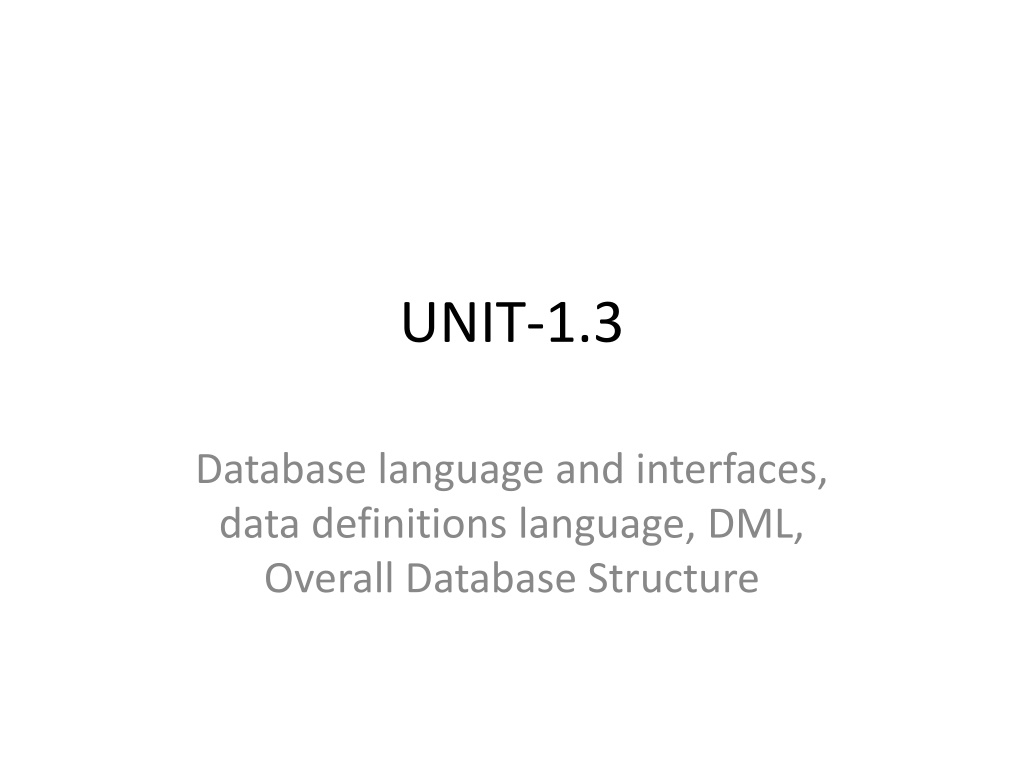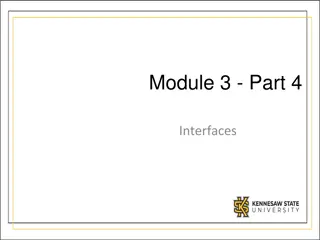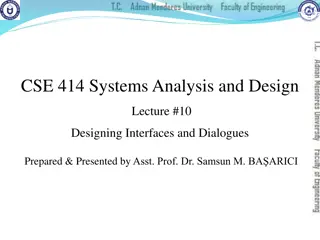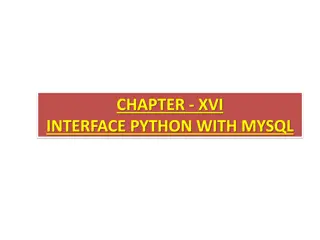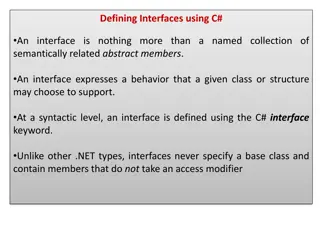Database Language and Interfaces Overview
A database management system (DBMS) requires appropriate languages and interfaces to handle queries and updates for data manipulation and control. This includes Data Definition Language (DDL), Data Manipulation Language (DML), Data Control Language (DCL), and Transaction Control Language (TCL). Each language serves distinct purposes in defining database structures, manipulating data, controlling access, and managing transactions efficiently within the database environment.
Download Presentation

Please find below an Image/Link to download the presentation.
The content on the website is provided AS IS for your information and personal use only. It may not be sold, licensed, or shared on other websites without obtaining consent from the author. Download presentation by click this link. If you encounter any issues during the download, it is possible that the publisher has removed the file from their server.
E N D
Presentation Transcript
UNIT-1.3 Database language and interfaces, data definitions language, DML, Overall Database Structure
Database Language A DBMS has appropriate languages and interfaces to express database queries and updates. Database languages can be used to read, store and update the data in the database. Types of Database Language
1. Data Definition Language DDL stands for Data Definition Language. It is used to define database structure or pattern. It is used to create schema, tables, indexes, constraints, etc. in the database. Using the DDL statements, you can create the skeleton of the database. Data definition language is used to store the information of metadata like the number of tables and schemas, their names, indexes, columns in each table, constraints, etc. Here are some tasks that come under DDL: Create: It is used to create objects in the database. Alter: It is used to alter the structure of the database. Drop: It is used to delete objects from the database. Truncate: It is used to remove all records from a table. Rename: It is used to rename an object. Comment: It is used to comment on the data dictionary. These commands are used to update the database schema that's why they come under Data definition language
2. Data Manipulation Language DML stands for Data Manipulation Language. It is used for accessing and manipulating data in a database. It handles user requests. Here are some tasks that come under DML: Select: It is used to retrieve data from a database. Insert: It is used to insert data into a table. Update: It is used to update existing data within a table. Delete: It is used to delete all records from a table. Merge: It performs UPSERT operation, i.e., insert or update operations. Call: It is used to call a structured query language or a Java subprogram. Explain Plan: It has the parameter of explaining data. Lock Table: It controls concurrency.
3. Data Control Language DCL stands for Data Control Language. It is used to retrieve the stored or saved data. The DCL execution is transactional. It also has rollback parameters. (But in Oracle database, the execution of data control language does not have the feature of rolling back.) Here are some tasks that come under DCL: Grant: It is used to give user access privileges to a database. Revoke: It is used to take back permissions from the user. There are the following operations which have the authorization of Revoke: CONNECT, INSERT, USAGE, EXECUTE, DELETE, UPDATE and SELECT.
4. Transaction Control Language TCL is used to run the changes made by the DML statement. TCL can be grouped into a logical transaction. Here are some tasks that come under TCL: Commit: It is used to save the transaction on the database. Rollback: It is used to restore the database to original since the last Commit.
ACID Properties in DBMS DBMS is the management of data that should remain integrated when any changes are done in it. It is because if the integrity of the data is affected, whole data will get disturbed and corrupted. Therefore, to maintain the integrity of the data, there are four properties described in the database management system, which are known as the ACID properties. The ACID properties are meant for the transaction that goes through a different group of tasks, and there we come to see the role of the ACID properties. In this section, we will learn and understand about the ACID properties. We will learn what these properties stand for and what does each property is used for. We will also understand the ACID properties with the help of some examples.
ACID Properties The expansion of the term ACID defines for:
1) Atomicity: The term atomicity defines that the data remains atomic. It means if any operation is performed on the data, either it should be performed or executed completely or should not be executed at all. It further means that the operation should not break in between or execute partially. In the case of executing operations on the transaction, the operation should be completely executed and not partially. Example: If Remo has account A having $30 in his account from which he wishes to send $10 to Sheero's account, which is B. In account B, a sum of $ 100 is already present. When $10 will be transferred to account B, the sum will become $110. Now, there will be two operations that will take place. One is the amount of $10 that Remo wants to transfer will be debited from his account A, and the same amount will get credited to account B, i.e., into Sheero's account. Now, what happens - the first operation of debit executes successfully, but the credit operation, however, fails. Thus, in Remo's account A, the value becomes $20, and to that of Sheero's account, it remains $100 as it was previously present. ACID Properties in DBMS
Consistency: The word consistency means that the value should remain preserved always. In DBMS, the integrity of the data should be maintained, which means if a change in the database is made, it should remain preserved always. In the case of transactions, the integrity of the data is very essential so that the database remains consistent before and after the transaction. The data should always be correct. Example: In the above figure, there are three accounts, A, B, and C, where A is making a transaction T one by one to both B & C. There are two operations that take place, i.e., Debit and Credit. Account A firstly debits $50 to account B, and the amount in account A is read $300 by B before the transaction. After the successful transaction T, the available amount in B becomes $150. Now, A debits $20 to account C, and that time, the value read by C is $250 (that is correct as a debit of $50 has been successfully done to B). The debit and credit operation from account A to C has been done successfully. We can see that the transaction is done successfully, and the value is also read correctly. Thus, the data is consistent. In case the value read by B and C is $300, which means that data is inconsistent because when the debit operation executes, it will not be consistent.
Isolation: The term 'isolation' means separation. In DBMS, Isolation is the property of a database where no data should affect the other one and may occur concurrently. In short, the operation on one database should begin when the operation on the first database gets complete. It means if two operations are being performed on two different databases, they may not affect the value of one another. In the case of transactions, when two or more transactions occur simultaneously, the consistency should remain maintained. Any changes that occur in any particular transaction will not be seen by other transactions until the change is not committed in the memory. Example: If two operations are concurrently running on two different accounts, then the value of both accounts should not get affected. The value should remain persistent. As you can see in the below diagram, account A is making T1 and T2 transactions to account B and C, but both are executing independently without affecting each other. It is known as Isolation.
Durability: Durability ensures the permanency of something. In DBMS, the term durability ensures that the data after the successful execution of the operation becomes permanent in the database. The durability of the data should be so perfect that even if the system fails or leads to a crash, the database still survives. However, if gets lost, it becomes the responsibility of the recovery manager for ensuring the durability of the database. For committing the values, the COMMIT command must be used every time we make changes. Therefore, the ACID property of DBMS plays a vital role in maintaining the consistency and availability of data in the database. Thus, it was a precise introduction of ACID properties in DBMS. We have discussed these properties in the transaction section also.
